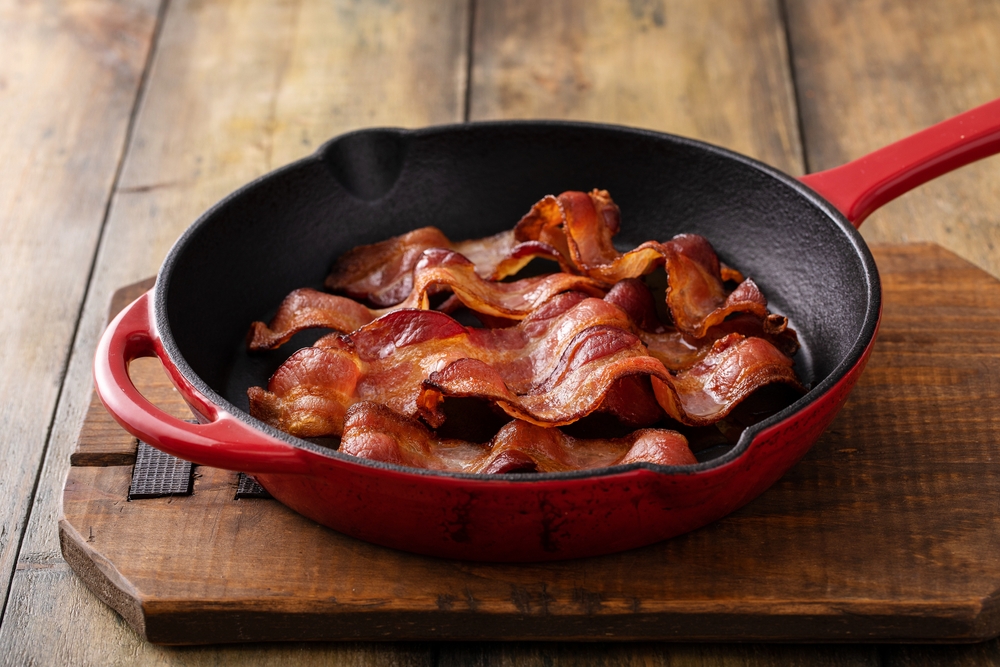
Bacon is one of those foods that seems simple to make, yet it often goes wrong in small but frustrating ways. Whether you like it crispy or chewy, cooking bacon the right way makes all the difference. Many home cooks rush the process or use the wrong pan, leaving the strips burnt, curled, or greasy. Learning a few basic techniques can turn your breakfast from average to excellent. If you care about flavor, texture, and less mess, understanding how to avoid these common bacon mistakes is worth the effort. Perfecting your method for cooking bacon ensures consistent, delicious results every time.
1. Starting with a Hot Pan
One of the biggest mistakes when cooking bacon is dropping the strips into a hot pan. Bacon needs time to render its fat slowly. When you start with a cold pan, the fat melts gradually, helping the bacon cook evenly and preventing tough edges. Suppose you toss it into a sizzling skillet, the outside crisps before the inside cooks through. The result is uneven texture and wasted flavor. Patience pays off here—let the pan heat up with the bacon inside, and you’ll achieve a better balance of crisp and chewy.
2. Using the Wrong Pan
The type of pan you choose affects how well your bacon cooks. A heavy cast-iron skillet distributes heat evenly, helping to prevent hot spots that can burn the meat. Thin pans often cause uneven browning and curled strips. Nonstick pans can work, but they sometimes trap steam, leaving the bacon limp. If you prefer baking bacon instead, use a rimmed sheet pan lined with foil or parchment for easier cleanup.
3. Crowding the Pan
It’s tempting to fit as many slices as possible into the skillet, especially if you’re cooking for a crowd. However, crowding the pan traps steam, making it difficult for the bacon to crisp. Each strip needs space for the fat to render and the edges to brown. If the pieces overlap, they’ll stick together and cook unevenly. It’s better to cook in batches and keep finished bacon warm in a low oven. This approach avoids soggy spots and ensures that every piece tastes just right. Cooking bacon properly means giving it room to breathe.
4. Skipping the Oven Option
Many people overlook the oven method, but it’s one of the easiest ways to get evenly cooked bacon with minimal mess. Baking the strips on a wire rack set over a sheet pan allows the fat to drip away, resulting in crisp, flat slices. The oven’s consistent heat cooks the bacon uniformly, and you can handle larger batches without flipping each piece. It also keeps grease splatter off your stovetop. If you’re short on time in the morning, you can even line the pan the night before. Cooking bacon in the oven is simple, efficient, and reliable.
5. Not Managing the Grease
Bacon grease is both a friend and a potential hazard. Leaving too much in the pan while you cook can cause spattering and burnt bits. Pouring it all out wastes a flavorful ingredient that adds depth to other dishes. The trick is balance. Keep enough fat in the pan to help the bacon crisp, but drain excess into a heatproof jar as you go. Once cooled, that grease can be used to fry eggs, roast vegetables, or add smoky flavor to cornbread. Managing grease properly keeps your kitchen cleaner and your meals tastier.
6. Forgetting to Flip (or Flipping Too Often)
Flipping bacon is an art. Some cooks flip too early and too often, while others let it sit too long. The best approach is to wait until the edges start to curl and the surface glistens with rendered fat before turning the strips. Usually, one or two flips are enough. Constant flipping interrupts the cooking process and can cause uneven texture. On the other hand, ignoring it completely risks burning one side. Watch closely, use tongs, and listen for that gentle sizzle that signals perfect progress when cooking bacon.
7. Not Letting It Rest
Once the bacon looks done, the urge to eat it right away is strong. But letting it rest for a minute or two on a paper towel-lined plate helps absorb excess grease. The cooling period also allows the bacon to firm up, giving it that ideal crispy bite. Skipping this step often leads to limp strips that taste oily instead of rich and savory. Think of it like resting a steak—just a short pause that locks in texture and flavor. Cooking bacon properly doesn’t end when it leaves the pan.
8. Ignoring the Quality of the Bacon
The best technique can’t fix poor-quality bacon. Thin, overly processed slices tend to shrink and burn quickly. Look for thicker cuts with visible marbling and minimal additives. Good bacon renders fat evenly and develops a deeper flavor as it cooks. If possible, buy from a local butcher or reputable brand that lists the curing process clearly. Spending a little more ensures better results and less waste.
Better Bacon, Every Time
Cooking bacon isn’t complicated, but small details make a big difference. Start cold, give each strip space, and pay attention to timing. Use a sturdy pan or try the oven for consistent results. Manage your grease, rest the bacon briefly, and choose quality cuts. When you respect the process, your breakfast plate rewards you with evenly cooked, flavorful strips that hold their crunch. Whether you’re serving a crowd or just making a quiet morning meal, mastering how you’re cooking bacon turns something ordinary into something satisfying.
What’s your favorite method for cooking bacon at home?
What to Read Next…
- 5 Mistakes That Are Costing You More at the Grocery Store Each Week
- Cook More at Home by Investing in a Kitchen Remodel
- 10 Things You’re Grilling Wrong According to Pitmasters
- 7 Popular Hot Dog Brands You Shouldn’t Put on Your Grill This Season
- 15 Genius Ideas for Cooking Cheap Yet Delicious Meals
The post Cooking Bacon? Avoid These Common Mistakes appeared first on Grocery Coupon Guide.







